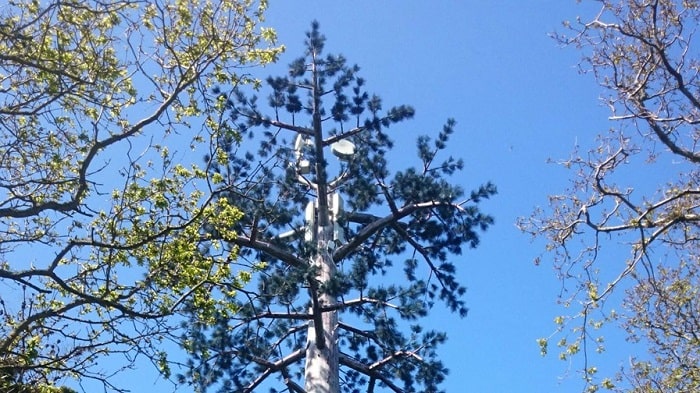Vivint rolls out new home internet service promising 5G-like speed

Vivint Internet, a spin-off of Lehi-based Vivint Smart Home, recently jumped in the race to bring 5G-class services to the public and an alternative to the monopolies and duopolies that dominate the Internet Service Provider (ISP) marketplace in most of the U.S.
Utilizing a combination of newly developed technologies and existing but underutilized fiber optic capacity, Vivint claims to have overcome the problem of connecting individual homes to fiber optic which has held back truly high-speed internet service and prohibited the speeds promised by 5G.
“There is an infrastructure piece of equipment and a networking piece and we’ve been able to merge them together which is something a lot of other companies haven’t been able to do,” said Hart who left Google fiber two years ago to join the Utah County start-up.
Excitement for 5G
The excitement over 5G comes from is just how much of an advancement it is. While the progression from 1 to 2 to 3G had noticeable differences, 5G systems promise an exponential change. Current 4G LTE cellular systems have a maximum download speed of about 100 Mbps (megabits per second). 5G systems promise speeds of up to 10 Gbps (gigabits per second) or 100 times faster than current systems. Cable and DSL (operating over phone lines) offer speeds ranging anywhere from 5 to 500 Mpbs. Upload speeds vary even more wildly and speeds for both can depend on how far away you are from the hub that connects to the main fiber optic line and how many other subscribers are on the same system. All DLS and cable systems eventually connect with fiber optic but it is those copper wire connections that slow the systems down. Average web surfing, email and watching streaming services like Netflix uses around 60 Mpbs.
Downloading an entire high definition film on a 5G system will take only a second, on-line games and even driver-less cars will respond in real-time and synchronize their speed with traffic lights and other cars. Current systems also impose data caps but 5G systems like the one proposed by Vivint will be unlimited.
The Race to 5G
Not surprisingly, technology companies are falling over themselves trying to bring the promise of 5G to the masses with several cellular phone companies already touting their 5G systems despite the fact that there are few phones on the market that can utilize it and delivering actual 5G speeds requires new infrastructure, like connections to fiber optic lines, to be built in most places.
“It is tricky and as a marketing term, 5G is already becoming so overused it can be hard to ascribe any real meaning to it,” said Richard Ricci a research associate professor in School of Computing at the University of Utah. Ricci says some companies have utilized some of the technologies related to 5G and marketed them under the label making it difficult for the average person to know exactly what they are getting.
At a technical level, 5G means the system utilizes an extremely high frequency portion of the radio spectrum often called the millimeter band (because of wavelengths ranging from 1-10 millimeters). While millimeter waves are good for transmitting large amounts of data, they don’t travel far and can be easily blocked by trees or buildings so for a 5G system to operate effectively it needs more cell towers, closer together connected to fiber optic lines.

Costs of 5G
While fiber optic lines are not uncommon and are used by many businesses and data centers, but connecting individual homes and a multitude of cell towers to the main fiber optic lines either underground or through overhead wires is disruptive and expensive. In addition, once the line to a home is installed, an individual homeowner may decide to change providers or get rid of the provider altogether at any time thus removing the incentive for any one company to install the line, to begin with.
According to Hart, Vivint will avoid the cost of installing new infrastructure by going around or rather, above the problem and will be taking advantage of the huge amounts of unused capacity on the existing fiber optic network.
The new Vivint system will tap into an existing fiber optic line and then run a line to a transmitter on a commercial building near a neighborhood.
“Those towers route to neighborhoods through strategically chosen ‘hub’ homes, using hardware the size of a normal salad bowl. The hub homes then provide internet to the surrounding neighborhood via a 5G wireless mesh network,” according to a press release from Vivint. The radio transmitters will utilize the high or millimeter wave frequencies of the 5G spectrum. The associated mesh network is a self-organizing system that routes data to the fastest channels in the network.
‘Cool’ 5G
“A lot of companies are utilizing millimeter wave technology and marketing it as 5G,” said Ricci. He noted once the signal is sent into homes and distributed to devices through wi-fi will be the real test of how fast the network is. “I don’t know if I would really call it 5G. Just looking at some of what they are proposing, I would say they could replace 5G with the word ‘cool’ and it would mean as much.”
Ricci said for some people like on-line gamers, and those who stream a lot of content it would be, “cool to have that kind of speed. And, it would be cool to have more choice in how you get internet service because the problem of the existing infrastructure and not having a real choice of internet providers and genuine high-speed connections are real problems. This looks like an interesting way to expand the reach of networks that otherwise would be very expensive to run into people’s homes.”
The company’s previous internet service operated on a similar “hub” type network and Hart said the company is building on that system and existing relationships with customers to introduce the new system.
“We give all our customers a top of the range, next generation WiFi mesh router which we connect to a 5G modem. This enables you to get the speeds by plugging your laptop into it, or by connecting to the router using WiFi on your current devices,” said Hart. “We can deploy networks quickly without having to dig, or string wires or get permission from cities and counties to install new infrastructure.”
Hart says the company has already conducted a successful pilot program in a Lehi neighborhood and will begin rolling out the service in select neighborhoods in the coming year.




